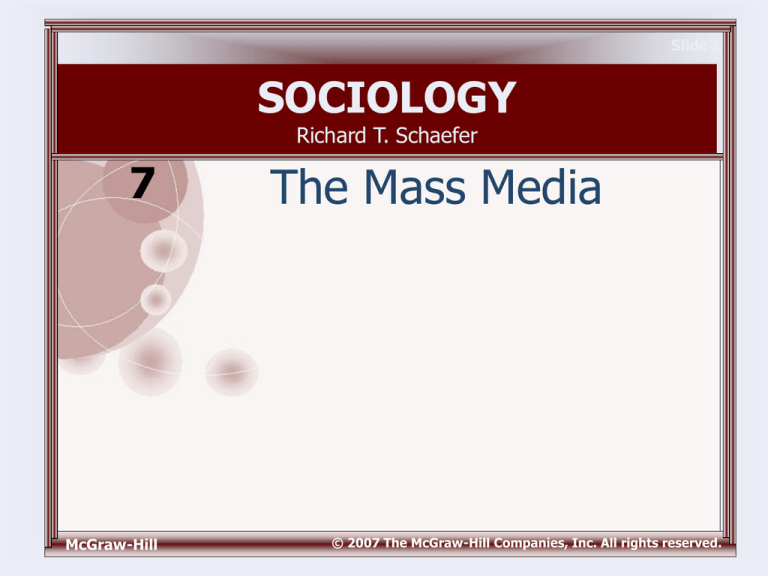
Slide 1
SOCIOLOGY
Richard T. Schaefer
7
McGraw-Hill
The Mass Media
© 2007 The McGraw-Hill Companies, Inc. All rights reserved.
Slide 2
7. The Mass Media
•
•
•
•
Sociological Perspectives of the Media
The Audience
The Media Industry
Social Policy and Mass Media
McGraw-Hill
© 2007 The McGraw-Hill Companies, Inc. All rights reserved.
Slide 3
Sociological Perspectives of the
Media
• Functionalist View
– The media:
• Socialize us
• Enforce social norms
• Confer status
• Promote consumption
• Keep us informed about our environment
• May act as a narcotic
McGraw-Hill
© 2007 The McGraw-Hill Companies, Inc. All rights reserved.
Slide 4
Sociological Perspectives of the
Media
• Functionalist View
– Agent of Socialization
• Media increases social cohesion by presenting
common view of culture
– Provide collective experience for members of a
society
– Socializing effects can promote religious as well as
patriotic exchanges, uniting believers around the
world
– Socializing effect of media means programming can
easily become controversial
McGraw-Hill
© 2007 The McGraw-Hill Companies, Inc. All rights reserved.
Slide 5
Sociological Perspectives of the
Media
• Functionalist View
– Enforcer of Social Norms
• Media reaffirm proper behavior by showing
what happens to people who violate societal
expectations
– Conferral of Status
• Singles out one from thousands of other
similarly placed issues or people to become
significant
McGraw-Hill
© 2007 The McGraw-Hill Companies, Inc. All rights reserved.
Slide 6
Sociological Perspectives of the
Media
• Functionalist View
– Promotion of Consumption
• Media advertising
– Supports economy
– Provides information
– Underwrites cost of media
McGraw-Hill
© 2007 The McGraw-Hill Companies, Inc. All rights reserved.
Slide 7
Sociological Perspectives of the
Media
Figure 7-1. Number of Hours per Week Spent with Media,
1997—2008 (projected)
Source: Veronis Suhler Stevenson LLC 2003:166-167 for 1997; 2004:184-185 for all other data
McGraw-Hill
© 2007 The McGraw-Hill Companies, Inc. All rights reserved.
Slide 8
Sociological Perspectives of the
Media
Table 7-1. Status Conferred by Magazines
McGraw-Hill
© 2007 The McGraw-Hill Companies, Inc. All rights reserved.
Slide 9
Sociological Perspectives of the
Media
• Functionalist View
– Surveillance of the Social Environment
• Surveillance Function: collection and
distribution of information concerning events in
the social environment
– Dysfunction: The Narcotizing Effect
• Narcotizing Dysfunction: phenomenon in
which the media provide such massive amounts
of information that audience becomes numb
and fails to act on the information
McGraw-Hill
© 2007 The McGraw-Hill Companies, Inc. All rights reserved.
Slide 10
Sociological Perspectives of the
Media
• Conflict View
– Conflict theorists emphasize that the media
reflect and even exacerbate many of the
divisions of our society and world,
including:
• Gender
• Race
• Ethnicity
• Social class
– Gatekeeping: how material must travel
through a series of checkpoints before
reaching the public
McGraw-Hill
© 2007 The McGraw-Hill Companies, Inc. All rights reserved.
Slide 11
Sociological Perspectives of the
Media
• Conflict View
– Dominant Ideology: Constructing Reality
• Dominant Ideology: set of cultural beliefs
and practices that help to maintain powerful
social, economic, and political interests
• Mass media serve to maintain the privileges
of certain groups
• Stereotypes: unreliable generalization
about all members of a group that do not
recognize individual differences within the
group
McGraw-Hill
© 2007 The McGraw-Hill Companies, Inc. All rights reserved.
Slide 12
Sociological Perspectives of the
Media
• Conflict View
– Dominant Ideology: Whose Culture?
• Globalization projects the dominating reach of the
U.S. media into the rest of the world
• Media cultural exports undermine the distinctive
traditions and art forms of other societies and
encourage their cultural and economic
dependence on the U.S.
Nations that feel a loss of identity may try to
defend against the cultural invasion
McGraw-Hill
© 2007 The McGraw-Hill Companies, Inc. All rights reserved.
Slide 13
Sociological Perspectives of the
Media
• Feminist View
– Feminists share conflict theorists’ view that
the mass media stereotype and
misrepresent social reality
• Women underrepresented
• Perpetuate stereotypical views of gender
• Emphasize traditional sex roles and normalize
violence against women
McGraw-Hill
© 2007 The McGraw-Hill Companies, Inc. All rights reserved.
Slide 14
Sociological Perspectives of the
Media
• Interactionist View
– Interactionists especially interested in
shared understandings of everyday
behavior
– Examine media on micro level to see how
they shape day-to-day social behavior
– Scholars increasingly point to mass media
as source of major daily activity
McGraw-Hill
© 2007 The McGraw-Hill Companies, Inc. All rights reserved.
Slide 15
Sociological Perspectives of the
Media
Figure 7-2. The Internet Explosion
Source: National Geographic 2005:21
McGraw-Hill
© 2007 The McGraw-Hill Companies, Inc. All rights reserved.
Slide 16
Sociological Perspectives of the
Media
Table 7-2. Sociological Perspectives
on the Mass Media
McGraw-Hill
© 2007 The McGraw-Hill Companies, Inc. All rights reserved.
Slide 17
The Audience
• Who Is In the Audience?
– Mass media distinguished from other social
institutions by necessary presence of
audience
– Identifiable, finite group or a much larger,
undefined group
McGraw-Hill
© 2007 The McGraw-Hill Companies, Inc. All rights reserved.
Slide 18
The Audience
• The Segmented Audience
– Increasingly, media market themselves
to a particular audience
– The role of audience members as
opinion leaders intrigues social
researchers
Opinion leader: someone who, through dayto-day personal contacts and communication,
influences opinions and decisions of others
McGraw-Hill
© 2007 The McGraw-Hill Companies, Inc. All rights reserved.
Slide 19
The Audience
• Audience Behavior
– Response often influenced by social
characteristics:
• Occupation
• Race
• Education
• Income
McGraw-Hill
© 2007 The McGraw-Hill Companies, Inc. All rights reserved.
Slide 20
The Media Industry
• Media Concentration
– Handful of multi-national corporations
dominate publishing, broadcasting, and
film industries
• The Media’s Global Reach
– Mass media have begun to create global
village in terms of communication
– Internet key to creating truly global
network
McGraw-Hill
© 2007 The McGraw-Hill Companies, Inc. All rights reserved.
Slide 21
The Media Industry
Figure 7-3. Media Penetration in Selected Countries
Source: Bureau of the Census 2004a:870
McGraw-Hill
© 2007 The McGraw-Hill Companies, Inc. All rights reserved.
Slide 22
Social Policy and Mass Media
• Media Violence
– The Issue
• What effect does movie and TV violence have
on audiences?
• Does violence in the media lead people,
especially youth, to become more violent?
McGraw-Hill
© 2007 The McGraw-Hill Companies, Inc. All rights reserved.
Slide 23
Social Policy and Mass Media
• Media Violence
– The Setting
• We spend great deal of time with the media
• Does watching hours of mass media with
violent images cause one to behave differently?
– Some studies linked exposure to media violence to
subsequent aggressive behavior
It is important to recognize that other factors besides the
media are also related to aggressive behavior.
McGraw-Hill
© 2007 The McGraw-Hill Companies, Inc. All rights reserved.
Slide 24
Social Policy and Mass Media
• Media Violence
– Sociological Insights
• If function of media is to entertain, socialize,
and enforce social norms, can violence be part
of that message?
• Even if viewer does not necessarily become
more violent from watching violent images,
there could be desensitization
McGraw-Hill
© 2007 The McGraw-Hill Companies, Inc. All rights reserved.
Slide 25
Social Policy and Mass Media
• Media Violence
– Sociological Insights
• Conflict and feminist theorists are troubled that
victims depicted in violent imagery are often:
–
–
–
–
–
–
McGraw-Hill
Women
Children
Poor
Racial minorities
Citizens of foreign countries
Physically disabled
© 2007 The McGraw-Hill Companies, Inc. All rights reserved.
Slide 26
Social Policy and Mass Media
• Media Violence
– Sociological Insights
• Interactionists especially interested in finding
out if violence in media may then become
script for real-life behavior
McGraw-Hill
© 2007 The McGraw-Hill Companies, Inc. All rights reserved.
Slide 27
Social Policy and Mass Media
• Media Violence
– Policy Initiatives
• Policymakers responded to links between
violence depicted in media and real life
aggression:
– Public statements of support for family-oriented,
less-violent media content
Reluctance to pass laws regarded as censorship
McGraw-Hill
© 2007 The McGraw-Hill Companies, Inc. All rights reserved.
Slide 28
Social Policy and Mass Media
Figure 7-4. Violence on Prime-Time Television, 1998—2002
Source: Parents Television Council 2003
McGraw-Hill
© 2007 The McGraw-Hill Companies, Inc. All rights reserved.






